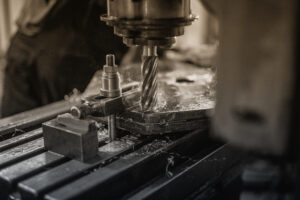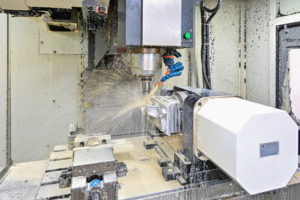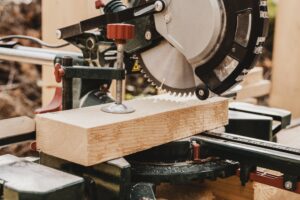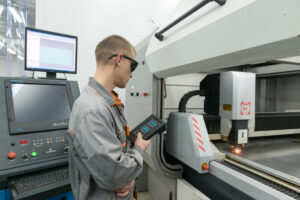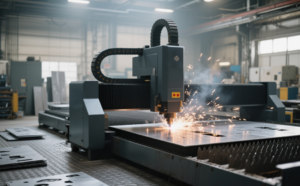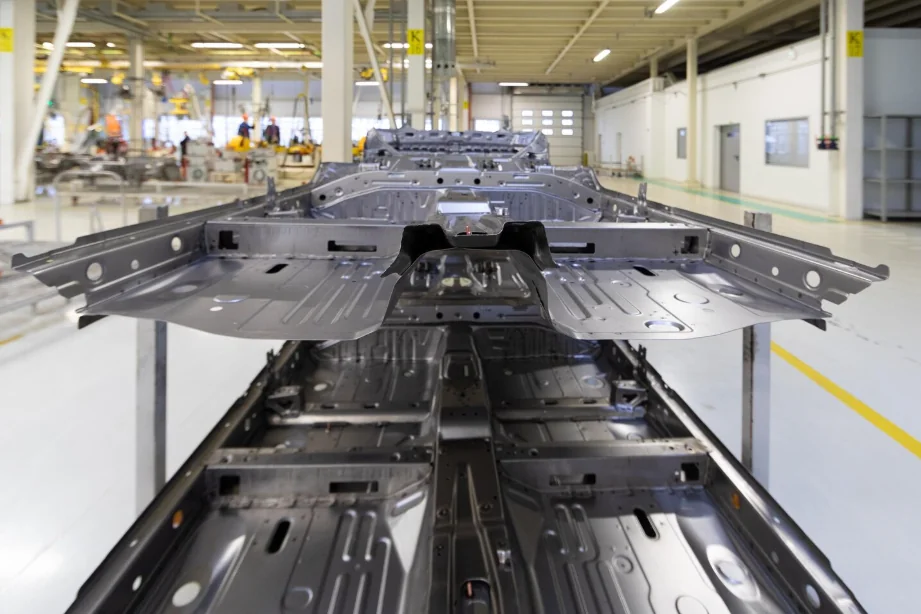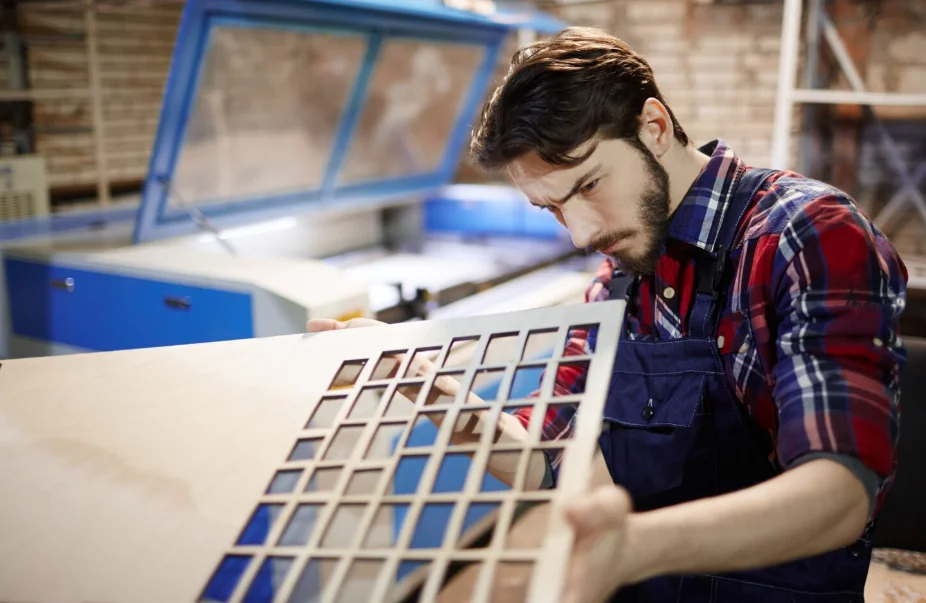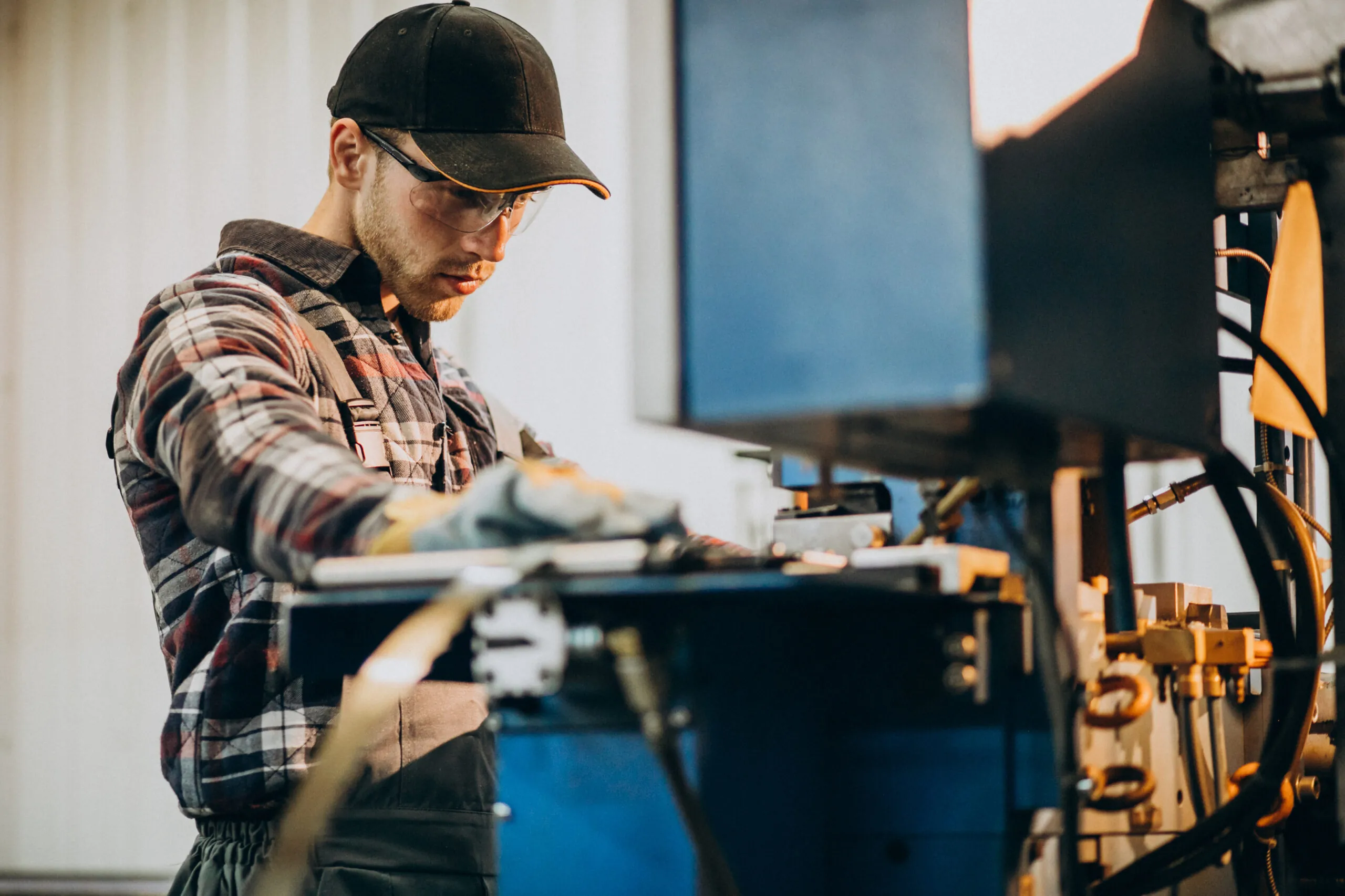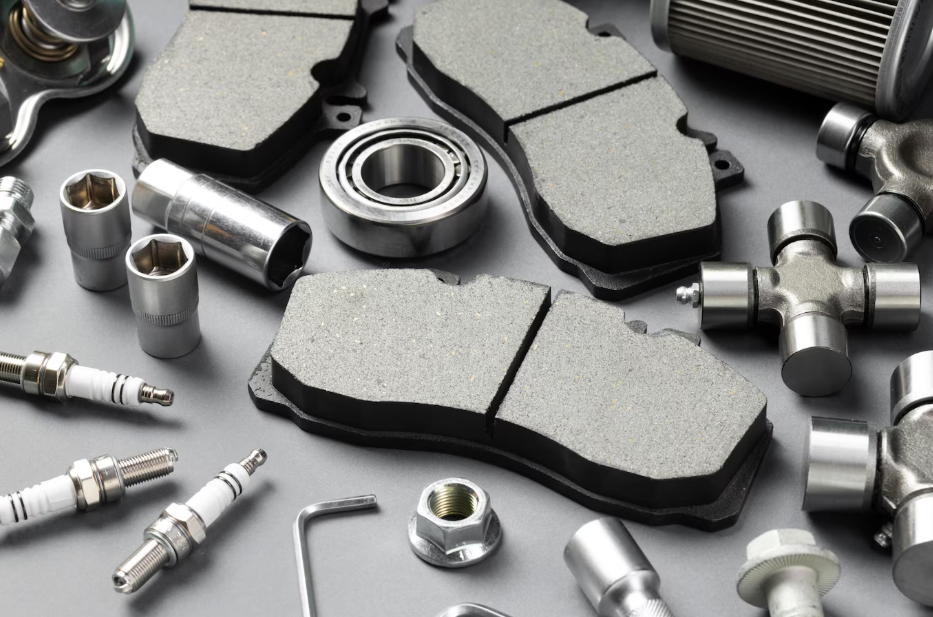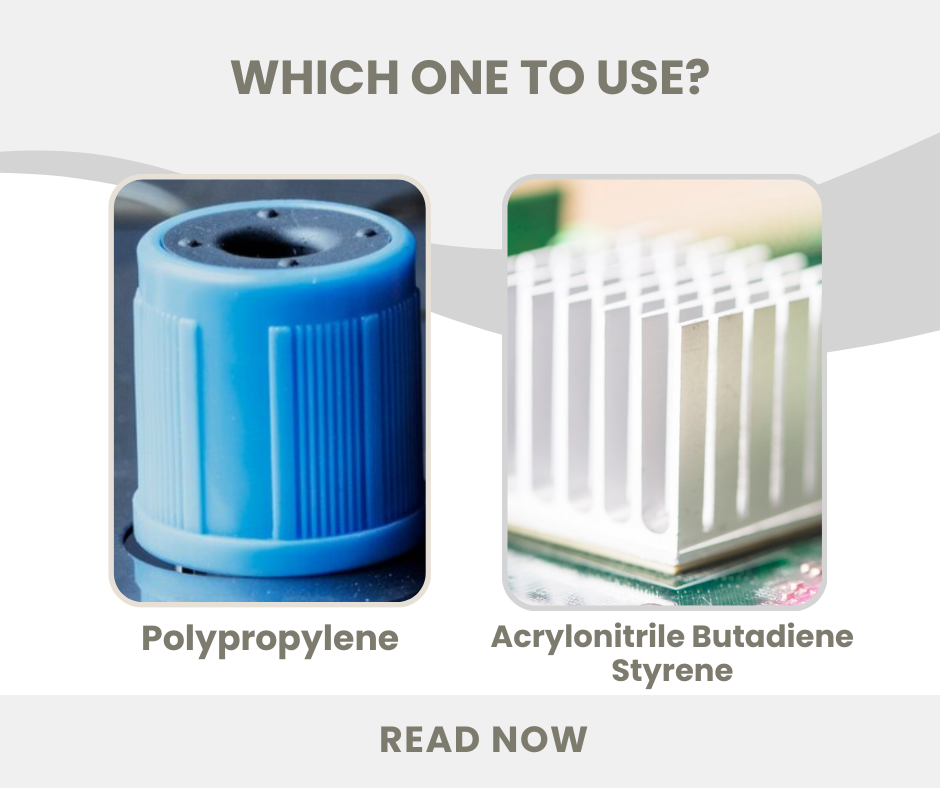All the types of CNC machining convert parametric CAD geometry into optimized G‑code. With closed-loop servo control, sub-5 μm repeatability, and thermal drift compensation, CNC machines ensure exceptional accuracy and stability. High-pressure coolant systems, adaptive feeds, and in-cycle probing further maximize efficiency and part quality.
These capabilities make CNC machining essential to modern precision manufacturing. This guide will present the types of CNC machines so you can select an appropriate configuration that fulfills your project requirements.
KEY TAKEAWYAS
💠 CNC Milling: Shapes flat/contoured surfaces; aerospace, automotive, prototypes.
🔄 CNC Lathes: Rotational parts like shafts/bushings; automotive, aerospace, medical.
🔹CNC Routers: Cuts/engraves wood, plastics, aluminum; furniture, signage, décor.
⚡ CNC EDM: High-precision machining of hard materials; molds, dies, electronics.
✂️ CNC Laser Cutting: Precise non-contact cutting; sheet metal, automotive, decorative.
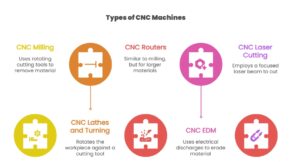
Table of Contents
ToggleCNC Milling
Material reduction through CNC milling takes place via computer-controlled rotary cutters that remove materials from products known as workpieces. The machine process executes instructions from G-code, which defines both tool paths and velocity rates as well as material removal settings.
Machines in the market extend from 3-axis machines to 5-axis systems, which execute complex geometrical shapes and tolerance requirements. The adaptability of CNC milling enables it to become essential among the different types of CNC machines.
| Advantages | Limitations |
| ✔️High precision (±0.0001″). ✔️Consistent repeatability. ✔️Efficient for multifaceted geometries. ✔️Wide material compatibility. ✔️Scalable from prototyping to production. ✔️Negligible operator intervention. ✔️Integration with CAD/CAM systems. | ⭕High initial investment. ⭕Material waste owing to its subtractive nature. ⭕Needs skilled programming and setup. ⭕Not ideal for very large parts. ⭕Tool wear and maintenance. |
Common Applications
The aerospace industry demands CNC milling for manufacturing turbine blades and structural airframe parts because precision and material uprightness play central roles in the sector. Besides, the automotive industry utilizes CNC milling machines to produce engine blocks and transmission housings together with custom-built components because they accomplish close-fitting tolerances and handle designs.
While using CNC milling for prototype development, engineers benefit from quick production times and precise matches of specifications, which helps across many industrial sectors during the research, testing, and development phases.
Copyright photo from https://www.freepik.com/free-photo/industrial-machine-drilling-metal_11138104.htm#fromView=search&page=1&position=1&uuid=3b45092c-f200-4e45-9e25-a4f0fd367324&query=CNC+Milling
CNC Lathes and Turning
The production of cylindrical shapes through CNC turning occurs when a workpiece spins while a fixed single-point cutting tool eliminates material from its surface. CNC milling and turning differ because milling keeps the workpiece in place while its rotating multi-point cutting tool subtracts material from the object to fabricate non-symmetrical complex shapes.
| Strengths | Drawbacks |
| ✔️High precision in producing cylindrical parts. ✔️Efficient for high-volume production runs. ✔️Capable of realizing tight tolerances. ✔️Suits a range of materials. ✔️Faster cycle times for symmetrical components. | ⭕Limited to parts with rotational symmetry. ⭕High initial investment and upkeep costs. ⭕Demands skilled operators for setup and programming. ⭕Less effective for complex, non-cylindrical geometries. ⭕Possible material waste due to subtractive process. |
Common Uses
The main application of CNC turning centers involves producing parts that need rotational symmetry, including but not limited to shafts, bushings, and fasteners. The procedure exists as a fundamental technology in automotive, aerospace, and medical device production, and it requires accurate and efficient cylindrical element generation. Of the numerous types of CNC machines, turning centers have particular characteristics for these applications.
CNC Routers
The CNC router system performs G-code translation from CAD models to control multi-directional hardware movements during the precise cutting and engraving of materials. The equipment demonstrates excellence in processing many material types, including but not limited to hardwoods, MDF, acrylics, and polycarbonates, along with aluminum and brass from the non-ferrous metal category.
| Pros | Cons |
| ✔️High repeatability and precision. ✔️Efficient for multifarious geometries. ✔️Abridged material waste. ✔️Lower labor overheads. ✔️Scalable for mass production. | ⭕Noteworthy initial investment. ⭕Entails skilled CNC machine operation and upkeep. ⭕Not ideal for very hard materials. ⭕Latent thermal deformation in plastics. ⭕Ordered calibration for accuracy. |
Relevant Use Cases
The CNC router demonstrates an unmatched aptitude for making complex details in cabinetry, furniture, and decorative objects, which maintains precise accuracy in woodworking applications. Plastic manufacturing benefits meaningfully from CNC routers because they fabricate exact items from materials such as acrylic and polycarbonate, which find widespread use in signage applications, displays, and industrial components.
The production of critical applications counts profoundly on their capability to maintain exact dimensional requirements.
Copyright photo from https://www.freepik.com/free-photo/front-view-carpentry-tool-machine_11105966.htm#fromView=search&page=1&position=18&uuid=3a144ad0-2b19-435a-9804-82d3c5ecd084&query=CNC+Routers
CNC EDM (Electrical Discharge Machines)
EDM performs material removal when controlled electricity discharges from an electrode to a conductive workpiece in dielectric fluid. The spark vaporizes extremely small amounts of material, which creates indentations on the surface. The non-contact thermal erosion technique of material removal allows for the high-precision manufacturing of shapes in hard materials.
| Benefits | Challenges |
| ✔️ Machines hardened materials (tool steels, carbides) with high precision. ✔️ Attains compound geometries and fine details. ✔️ No mechanical contact—disregards cutting forces. ✔️ Slight residual stresses and burr-free surfaces. ✔️ Produces micro-features with high aspect ratios. ✔️ Precise control over surface finish and dimensional accuracy. ✔️ Can machine deep cavities and narrow slots. ✔️ Benefits small hole drilling in aerospace components. | ⭕ Limited to electrically conductive materials. ⭕ Relatively slow material removal rates. ⭕ Electrode wear affects dimensional accuracy. ⭕ High power consumption. ⭕ Formation of recast layers that demand post-processing. ⭕ High initial equipment and maintenance costs. ⭕ Needs skilled operators for performance. |
Precision Applications
EDM proves essential for the production of precise components, which includes injection molds together with extrusion dies and stamping tools. The technology permits engineers to make convoluted features in hardened steel tooling while producing sharp interior angles and tiny cavities.
EDM drills cooling holes for turbine blades in aerospace applications, while manufacturing electronics demands it to build fine features in molds and components related to semiconductor production.
Copyright photo from https://www.freepik.com/free-photo/production-electronic-components-high-tech-factory_1285552.htm#fromView=search&page=1&position=2&uuid=6a0e0e13-9834-4c06-875a-ab7b9e83610e&query=CNC+EDM+%28Electrical+Discharge+Machines%29
CNC Laser Cutting
The process of CNC laser cutting controls a computer-operated laser beam that performs precise material vaporization, melting, or burning according to programmed paths. A well-managed laser beam and its movement allow precise cuts using CNC laser technology. The addition of oxygen or nitrogen as an assist gas helps remove molten material to realize clean edge quality.
| Advantages | Limitations |
| ✔️ High precision with tolerances up to ±0.0005 inches (±0.0127 mm). ✔️ Non-contact process diminishes material deformation. ✔️ Capable of multifaceted geometries. ✔️ Negligible kerf width for lower material waste. ✔️ Handy across materials, including metals and non-metals. ✔️ Rapid prototyping with quick setup times. ✔️ Easily integrates with CAD/CAM systems. ✔️ Automation-friendly for continuous production. | ⭕ High initial investment and conservation costs. ⭕ Limited effectiveness on reflective copper and aluminum. ⭕ Thickness limitations; less effective on very thick materials. ⭕ Probable thermal distortion in heat-sensitive materials. ⭕ Obliges ventilation owing to fumes and gases produced. ⭕ Energy-intensive, which triggers higher operational costs. ⭕ Safety concerns due to high-power lasers. ⭕ Not apposite for materials that release toxic fumes when cut. |
Suitable Applications
CNC laser cutting operates best when working with precise projects that need tricky features. The laser cuts elaborate markings within metal and plastic materials and wooden surfaces, which mark serial production numbers and decorative styles.
Additionally, the CNC laser cutter provides high-accuracy processing for stainless steel and aluminum sheets in the production of automotive and aerospace parts. The technology lets users develop both detailed decorative elements and tooling markers in numerous materials for signage production.
Laser cutters excel among the types of CNC machines when precision and waste reduction form the core requirements for a task.
Work with APT for Expert CNC Machining Services
Investing in expensive CNC machinery is not always necessary to achieve precision manufacturing results. Partnering with the right CNC machining service provider can offer the same level of quality, efficiency, and flexibility—without the need for major capital investment, regardless of the types of CNC machines required for your project.
APT-Mold delivers expert CNC machining services across a full range of technologies, including 3-axis, 4-axis, and 5-axis milling, as well as CNC turning with live tooling. We work with over 60 types of engineering-grade materials, from metals like aluminum and stainless steel to high-performance plastics such as ABS.
At ATP-Mold, we deliver full production support, from rapid prototype generation to large-scale manufacturing service, alongside quick delivery schedules and quality control. If you want CNC solutions customized to your needs, please reach out to us.

